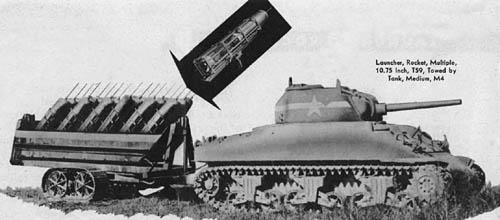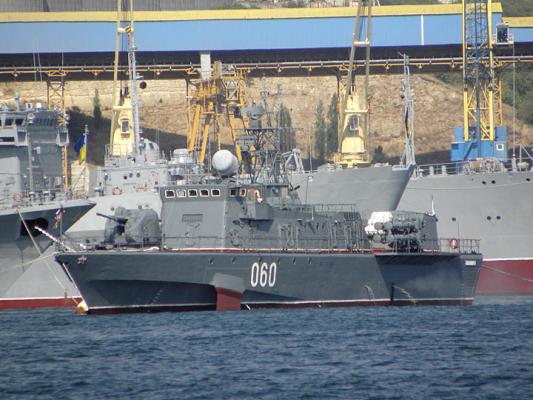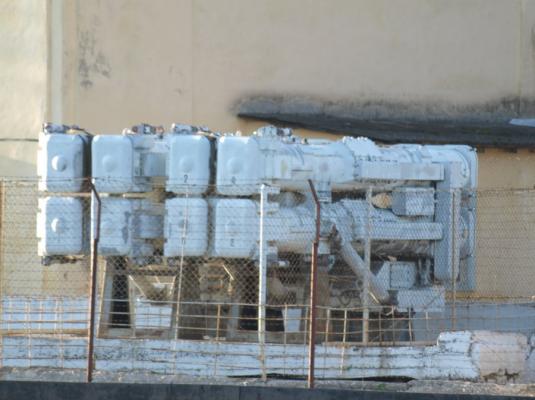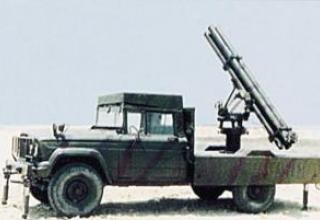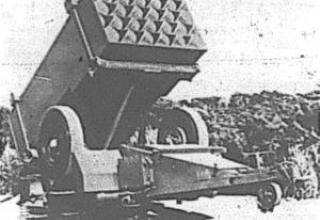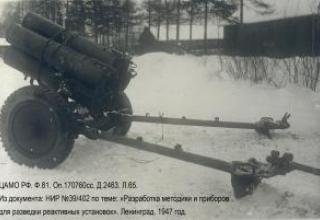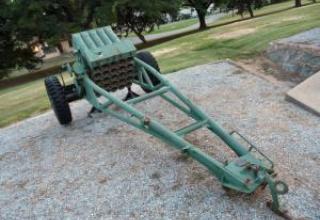The T59 towed multi-charger was designed to provide fast passageways in anti-tank minefields with sufficient width to pass tanks.
The system was developed in the United States of America in the middle of World War II.
The system was part of the system:
- towed multi-charger T59;
- unguided T91 273mm rocketshell;
- medium M4 tank for towing the plant.
The throwing unit (artillery unit) was mounted on a six-ton tracked trailer Athey. Six groups of three tracked rails with 273mm rockets were placed in a row at an angle of 45° in an armored case, which was attached to the base of the cradle type, attached to the chassis and in turn provides a constant automatic horizon at angles up to 15°.
The projectiles were fired in series during movement when electric signals were received from a special mechanism mounted on the launcher. This mechanism allowed one projectile to be fired every 4.6 meters. A manual firing panel was mounted inside the tank. The launcher could be reset at any time by means of a remotely controlled explosive charge, which was detonated by the signal from inside the tank. The T59 provided mine clearance with a probability of at least 85% of the straight line for the tank with a cross section of up to 3.7 m.
A firing test with 18 rockets was carried out at a range mined with indicator mines similar to the German Teller mines and buried at a minimum depth of 100mm. The depth of the minefield was about 82m. During the tests the projectiles were launched in sequence at 4.6m intervals. As a result, the T59 tank passed through the range without encountering a workable mine (see diagram). During the course of the tests, the projectiles were not launched at two consecutive intervals due to one mechanical and one operational failure. This reduced the width of the cleared corridor to approximately 4.6 m. For the rest of the journey, the minimum corridor width was about 16.5 meters. The calculated maximum depth of a minefield through which all rockets of one plant could pass in the absence of a launch system failure was approximately 152m.
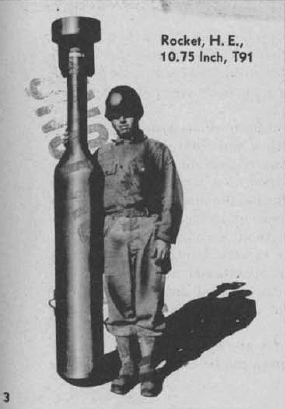
The T-91 projectile consisted of a cylindrical body with a diameter of 273 mm with a hemispherical head part (supercaliber) and a conical base. The wall thickness of the case was 2.54 mm. The projectile was equipped with an M120A1 bomb head fuse, which was modified to reduce the firing time from 2.5 to 1.6 seconds. A further modification was to use a 457 mm long headstock to provide an airborne detonation of the ammunition, which significantly reduced the effect of cratering. During the tests, the size of the funnel produced by the explosion was about 0.15 m deep and about 3 m in diameter. The T22 rocket engine, 114.3 mm in diameter, was attached to the conical base of the projectile. A large-diameter cylindrical stabilizer was placed on the cut of the engine nozzle.
(Note that the use of the head rod in the remote demining projectile was also used in the design of the Chinese Type 81 (Type 81 II) 253 mm caliber projectile to be launched with the Type 81 combat vehicle, which was in service with the People's Liberation Army of China in the early 21st century (see photo).
Composition:
The composition of the complex:
- Anti-submarine missile 87R with a warhead - torpedo MPT-1UE;
- launcher;
- loading device;
- firing control system;
- power supply system;
- ground equipment set;
- training means;
- set of spare parts, tools, accessories and materials.
The 87P anti-submarine missile (see diagram) consists of a solid propulsion system and a warhead, including a range control unit and a small-size anti-submarine torpedo with a braking and stabilization system (BS). Control of the missile by the range is carried out by zeroing the engine thrust with its separation when the calculated range is reached, which is calculated by the firing control system and entered into the missile before launch. After separation of the engine, the torpedo is lowered into the water by parachute. The rocket is not controlled by the azimuth. The accuracy of firing in this direction is ensured by the choice of the starting moment when the firing line coincides with the direction to the target. Realized in the complex sighting scheme and algorithms of generating the launch torque stipulate high accuracy characteristics when firing from unstabilized PU. Aerodynamic stability of rockets in the air part of the trajectory is provided by stabilizers, which open when the rocket leaves the launcher.
The combat unit of missile 87R - torpedo MPT-1UE with a braking and stabilization system (STS). MPT-1UE torpedo is designed to combat submarines with a cruising speed of up to 35 knots at a diving depth of 15 to 600 meters. The torpedo is equipped with an acoustic homing system that allows salvo use and provides guidance to low-noise submarines using acoustic countermeasures devices. Control system on course and depth leads the torpedo to the target with the necessary accuracy, and the combat charging compartment ensures the destruction of the submarine as a direct hit, and when the torpedo passes the target. The torpedo is equipped with a powerful axial piston engine on unitary fuel, reliable and safe in operation by placing the fuel in an ampoule tank. The torpedo does not require maintenance when stored in a container at temperatures ranging from - 50 ° to + 50 ° C for 10 years. To ensure combat training the torpedo is used in the training version, which allows to obtain the necessary information in case of repeated use. Modular design allows to upgrade the torpedo according to the customer's requirements (for example, to increase range, to use against surface ships). Design features of the complex allow for the use of other torpedoes of the same class, such as the torpedo type Mk-46. Complete delivery of BC is possible, allowing to use it from aircraft carriers (planes, helicopters).
Launching unit (PU) of the complex - nonstabilized, lifting with a sloping start. The PU is a package of four barrels enclosed in a common clip, made of light aluminum alloy (see photo). Its main feature is the absence of vertical and horizontal guidance in the design of power tracking drives, which provides a small weight-size characteristics. The starter unit can be made in a two-barrel version. It is possible to place the PU on the coastal starting position. For large displacement ships, a version of the guided PU on a swivel base has been developed.
An upgraded version of the Medvedka-2 complex has been developed to accommodate and launch missiles from the ships' vertical launchers. The vertical launch rocket uses a new autonomous control system compartment, which uses a block of command devices, on-board computer, steering drive and other elements from the composition of other products currently in mass production. The missile is launched using a powder pressure accumulator from the transport and launch container by means of a mortar circuit, which reduces the gas-dynamic impact on the carrier ship structures. After leaving the container, the missile makes a U-turn towards the target, after which the marching rocket engine is activated. The Medvedka-2 complex is part of the frigates of the 22350 project.
The firing control system is designed to control the ship's anti-submarine weapons and provides control of single and multiple launch (up to 4 in a salvo) firing of rockets from two four-pipe launchers against submarines (the current target location, the predicted point and the area of possible target position), mine and anti-submarine fences.
The complex solves the following functional tasks:
- automatic data reception from LAG, pointer and gyrocompass
- automatic or manual input of target designation and meteorological data
- target production
- generation of firing data at the present and forecasted target location and by possible target location area
- Determining the probability of impact and making recommendations on the number of missiles assigned to the volley
- control of launchers (fixed angle lifting, opening and closing covers, lowering)
- display on the control panel all information about the progress of pre-start preparation
- course development
- starting torque detection
- input and control of firing data entry through main and reserve channels
- rocket data storage
- documenting
- personnel training
- accidental release of rockets (battery powered)
The complex can be used in any climatic conditions, sea disturbance up to 6 points and in the whole speed range of the carrier ship. Ready to start time - 15s (without taking into account the pointing time and from the moment of receiving data about a target at the submitted supply voltage and at the accelerated methods of firing).
Characteristics:
General characteristics
| Effective radius of impact of T91 projectile on German Teller mines at the depth of 100mm | 6,1 |
| Maximum firing range (installation stationary), m | 38 |
| Angle of exit, installation in hiking position, rough terrain (with funnels) | 45°±8° |
| The path interval between projectile launches, m. | 4,6 |
| Tank and installation speed when driving over rough terrain (with funnels), km/h. | 4,8 |
| Standard deviation of the projectile in range when fired from a rig towed over rough terrain (with funnels), m | 1,5 |
| Number of shells, pcs. | 18 |
| Depth of minefield to be cleared, m | around 95 |
Characteristics of M4 medium tank
| Length, mm | 6700 |
| Width, mm | 2130 |
| Height (knocked up), mm | 2430 |
| Armour protection; front, back, sides, mm | 25,4 |
| Weight in uncooked condition, kg | 7643 |
| Weight in gear, kg | 10433 |
Characteristics of T91 projectile
| Caliber, mm | 273 |
| Length, mm | 1981 |
| Breaking charge type | cast TNT (trinitrotoluene, tol, TNT) |
| Weight of explosive charge, kg | 109 |
| Total weight, kg | 145 |
The presented characteristics are rounded.
Testing:
As of 01.01.1950, the factory batch of 230 shells was completed and sent to the Pavlograd test site.
In November 1949, pre-factory tests of 34 shells were carried out together with the fuse B-377 during which cases of missiles were revealed.
Special tests carried out to determine the causes of deficits showed that the most probable cause was an increased release of unburned reactive charge particles at the end of the active section of the trajectory.
In order to eliminate this phenomenon, in December 1949 a bench-top refinement of the engine was started with regard to aperture enhancement and ensuring that the powder charge was fixed in the chamber. After the end of the bench work and experimental firing for checking the reinforced aperture, the factory batch of projectiles was to be equipped with modified apertures on site and presented for factory tests in February 1950.
Sources:
- http://www.lonesentry.com/manuals/multiple-rocket-launcher-t59/index.html
- http://www.scribd.com/doc/38789988/Launcher-Rocket-Multiple-10-75-Inch-T59-1944
- Jane's Armour and Artillery 2000-2001. - P.763.
- Jane's Ammunition Handbook 2000-2001. - P.630.
